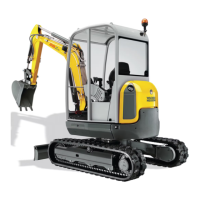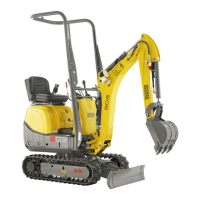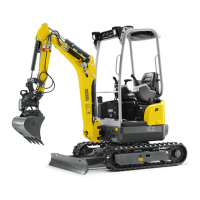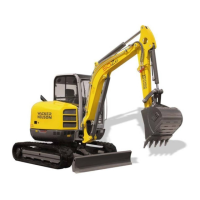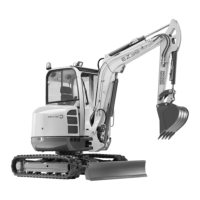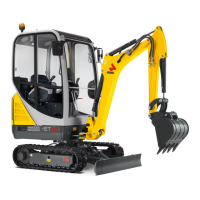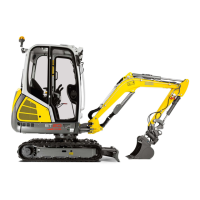
Do you have a question about the Wacker Neuson 2503 and is the answer not in the manual?
| Brand | Wacker Neuson |
|---|---|
| Model | 2503 |
| Category | Excavators |
| Language | English |
Covers the operation of the Track Excavator.
Specifies models covered by the operator's manual.
Provides an overview of the manual's sections and general information.
Details critical safety information and procedures for operating the machine.
Explains how to operate the machine's controls and systems.
Provides guidance on using and storing the operator's manual.
Defines abbreviations and symbols used throughout the manual.
Illustrates and labels the main external components of the machine.
Describes the machine's main components, applications, and key systems.
Details the machine's uses and lists compatible attachments with specifications.
Outlines operator requirements, warranty conditions, and legal observations.
States compliance with EU directives for model 2503.
Explains identification labels, serial numbers, and their locations on the machine.
Explains various signs and symbols found on the machine for safe operation.
Provides a visual overview of the safety labels and their locations on the machine.
Defines signal words (DANGER, WARNING, CAUTION, NOTICE) and their meanings.
Explains warranty claims process and where to direct them.
Provides instructions for proper disposal of fluids and materials.
Outlines essential conditions for safe machine operation and user responsibilities.
Details pre-operation checks and personal safety measures before starting work.
Highlights the importance of understanding and checking the work site environment.
Explains safety precautions for operating with a raised or lowered rollbar.
Details the function and safety measures for the optional shatter protection.
Specifies limitations and safety for lifting gear applications, noting it's not permitted.
Provides critical steps before coupling/uncoupling hydraulic lines and attachments.
Covers safety instructions and precautions specific to operating with a hammer attachment.
Details procedures and safety guidelines for transporting and towing the machine.
Outlines essential personal safety measures and precautions for maintenance work.
Provides detailed safety guidelines for carrying out maintenance and repair tasks.
Highlights hazards and safety precautions related to the machine's electrical system.
Addresses safety considerations when working in environments with hazardous substances.
Details safety hazards and precautions for handling and working with the machine's battery.
Introduces the operation chapter, explaining symbols and referencing controls.
Illustrates the cabin layout and numbered controls for older models.
Details the purpose and location of each control element within the cabin.
Explains the function of each indicator light and gauge on the instrument panel.
Covers initial setup, first-time operation, and the running-in period for the machine.
Provides a list of essential checks to perform before starting the engine or machine.
Lists checks to perform during and after operation to ensure safe functioning.
Details checks required when parking the machine, including on slopes and public roads.
Explains how the throttle controls engine speed for Tier III and Tier IV engines.
Explains the meaning of various red and yellow indicator lights for Tier III engines.
Illustrates the digital display element and its associated buttons for Tier IV models.
Table defining symbols, colors, designations, and corresponding page numbers for the display.
Explains the meaning of various symbols and displays on the Tier IV multifunctional display.
Explains the function of the hour meter for tracking engine operating hours.
Describes the maintenance meter that counts down to the next service interval.
Details the multifunctional display and its associated buttons for Tier IV models.
Describes how to access and adjust display settings like brightness and contrast.
Lists essential checks and preparations to be completed before starting the engine.
Provides a step-by-step procedure for starting the machine's engine.
Details the procedure for starting the machine using the optional immobilizer system.
Provides specific procedures for starting the engine in cold weather conditions.
Explains how to initiate machine movement after starting the engine.
Describes the function and operation of the drive levers for machine movement.
Explains how to activate high speed for models 2503 and 3503 (Auto 2-Speed).
Describes the function of the hydraulic brake system.
Details safety precautions and procedures for operating the machine on slopes.
Explains the operation and safety precautions for using the stabilizer blade.
Details the operation of the slewing stabilizer blade for model 3503.
Provides instructions and warnings for parking the machine on inclines.
Explains the operation of the working lights and associated warnings.
Describes the operation of optional roof lights and related warnings.
Describes the operation of the optional rotating beacon and related information.
Defines protective structures and outlines hazards associated with modified or missing structures.
Explains the different levels of protection offered by FOPS/Front Guard structures.
Details the installation and specifications for a Category I FOPS structure.
Describes the installation and safety requirements for a Category I Front Guard.
Details the function and safety measures for the optional shatter protection.
Explains how to use emergency exits, including the rear window and emergency hammer.
Describes the cabin's air circulation system, including heating and ventilation controls.
Explains the operation of the front wiper and washer system.
Details the procedures for adjusting the operator's seat for comfort and safety.
Explains how to adjust the seat suspension based on operator weight for ride comfort.
Provides crucial safety information and instructions for fastening and using the seat belt.
Details the procedure for opening and closing the front window safely.
Explains how to open, lock, unlock, and secure the machine's door.
Provides instructions for safely entering and exiting the machine when equipped with a canopy.
Details safe procedures for entering and exiting the machine's cabin.
Explains how to open and close the engine cover for maintenance access.
Covers important safety information and procedures for towing the machine.
Provides crucial safety information and procedures for lifting the machine with a crane.
Details safety instructions and procedures for loading and transporting the machine.
Explains how to securely tie down the machine for transport using approved devices.
Covers general safety instructions and warnings for operating the excavator.
Explains the function and operation of the optional Wacker Neuson Vario feature.
Details safety precautions for driving across slopes using the Vario feature.
Describes how to work with the Vario feature for improved reach and stability.
Explains the functions of the left control lever, including auxiliary hydraulics.
Details how to control the boom's swivel movement using the left control lever.
Explains the functions of the right control lever for boom, bucket, and tilt operations.
Illustrates and explains the functions of the left control lever in SAE configuration.
Illustrates and explains the functions of the right control lever in SAE configuration.
Explains how to changeover between ISO and SAE control patterns.
Introduces proportional control options and their characteristic curves.
Provides guidance on handling system breakdowns and potential malfunctions.
Explains how to interpret the diagnosis display and status indicators.
Details the operation of auxiliary hydraulics using proportional controls.
Explains how to operate the hammer attachment with proportional controls.
Describes how to rotate the upper carriage safely, including brake functions.
Explains the procedure and safety for tilting the upper carriage with the VDS option.
Provides critical steps for releasing hydraulic pressure before maintenance or attachment changes.
Covers specific safety instructions and procedures for fitting/removing attachments.
Details the step-by-step procedure for safely removing a bucket attachment.
Provides a step-by-step guide for safely installing a bucket attachment.
Explains the safety precautions and procedures for using the mechanical quickhitch.
Covers safety precautions and operation procedures for the hydraulic quickhitch.
Details the step-by-step process for safely picking up an attachment using the quickhitch.
Provides instructions for safely setting down an attachment using the quickhitch.
Details the two versions of Powertilt, their operation, and safety warnings.
Provides a step-by-step procedure for installing the Powertilt unit.
Details the procedure for safely removing the Powertilt unit.
Explains how to connect hydraulic lines to the Powertilt unit and route them.
Describes how the left control lever operates the Powertilt functions.
Details procedures for coupling, uncoupling, and operating the grab attachment.
Explains the function and operation of the safe load indicator and overload warnings.
Covers inadmissible work procedures to avoid damaging the machine or attachment.
Provides instructions to ensure the bucket does not hit the stabilizer blade when retracting.
Describes the optimal position of the machine and bucket for efficient digging.
Provides tips for efficient trench excavation and positioning.
Details precautions to avoid damaging components when working near trenches.
Offers additional advice for planning and executing digging operations effectively.
Explains the Tier IV exhaust gas treatment system and regeneration process.
Warns about fire hazards during regeneration and precautions to take.
Explains load indications related to particulate matter catalyst contamination levels.
Details the meaning of indicator lights related to the particulate matter catalyst.
Describes the functions of the regeneration push button and its indicator lights.
Explains how to disable, interrupt, or re-enable the automatic regeneration mode.
Provides instructions for initiating and interrupting manual regeneration.
Lists possible causes and solutions for engine starting issues.
Covers causes and solutions for low or absent engine oil pressure.
Details possible reasons for excessive engine oil consumption.
Lists common malfunctions of the Powertilt unit and their potential causes.
Explains the engine warning lights and related error codes for Tier IV engines.
Details engine and oil warning lights for Tier IV, including causes and actions.
Lists malfunctions indicated on the display element and multifunctional display for Tier IV.
Provides guidance on interpreting engine error messages displayed on the multifunctional display.
Emphasizes the importance of maintenance for machine readiness and service life.
Covers refueling, fuel system bleeding, and stationary fuel pump usage.
Provides safety precautions if refueling from barrels is unavoidable.
Details the procedure for safely draining fuel from the tank.
Explains when and how to bleed the fuel system to remove air.
Describes how to check and drain the water separator for the fuel system.
Provides a step-by-step guide for checking the engine oil level.
Details the correct procedure for adding engine oil to prevent damage.
Explains the cooling system, radiator maintenance, and coolant safety.
Warns about the hazard of burns from hot fluids when checking coolant.
Provides instructions for checking and adding coolant to the engine and radiator.
Explains air filter maintenance, replacement, and indicators for contamination.
Provides a step-by-step guide for replacing the air filter element.
Covers specific safety instructions for working on the hydraulic system.
Provides a detailed procedure for checking the hydraulic oil level and its operating temperature.
Details the safe procedure for adding hydraulic oil, including pressure release.
Provides guidelines and precautions for using biodegradable hydraulic fluids.
Highlights dangers of high-pressure fluid escape and safety instructions for checking lines.
Covers track wear and tension checking, with warnings about crushing hazards.
Provides instructions and safety warnings for checking and adjusting track tension.
Details the procedure for setting track tension, with warnings about lubricant escape.
Covers wear checks and replacement guidelines for lifting eyes and load hooks.
Covers specific safety instructions for working with the electrical system.
Provides instructions for specific components like cables, bulbs, fuses, and the alternator.
Details caustic and explosion hazards associated with batteries and their handling.
Covers general cleaning procedures for the machine.
Provides general guidelines for cleaning with solvents, compressed air, and high-pressure jets.
Offers recommendations for cleaning the machine's interior cabin.
Emphasizes regular checks for tightness of threaded fittings.
Recommends regular lubrication of mechanical pivot points and fittings.
Details lubrication points and procedures for the slewing cylinder and live ring.
Provides daily lubrication instructions for points on the stabilizer blade.
Details the procedure for lubricating the teeth of the live ring VDS.
Specifies weekly lubrication points for the VDS system.
Details the two versions of Powertilt, their operation, and safety warnings.
Details lubrication points and pre-use checks for the hydraulic quickhitch.
Lists essential steps to prepare the machine for extended storage.
Provides guidance on decommissioning and disposing of the machine responsibly.
Details the steps required to put a machine back into operation after storage.
Provides guidelines and precautions for using biodegradable hydraulic fluids.
Explains when additional hydraulic oil changes and filter replacements may be needed.
Provides a chart showing recommended hydraulic oil grades based on ambient temperature.
Details required oil and filter changes based on operating hours and inspections.
Instructions for draining condensation water from the hydraulic oil reservoir.
Procedure for draining fuel/water mixture from the fuel filter.
Lists components requiring lubrication and their intervals.
Outlines functional checks for various assemblies and components.
Details checks for tightness, leaks, and chafing on pipes and lines.
Lists engine oil and filter change intervals and other service tasks.
Lists daily inspection tasks for the user to perform.
Outlines service tasks to be performed by a Wacker Neuson service center after the first 50 operating hours.
Explains the function of the maintenance meter and its indicators.
Provides detailed specifications for the engine used in Model 2503.
Details track specifications, including width and ground pressure.
Presents specifications for the Model 3503, including engine details.
Lists specifications for the hydraulic system of Model 3503.
Provides dimensions and specifications for the stabilizer blade.
Details engine specifications for Model 3503 with Tier III engine.
Provides engine specifications for Model 3503 with Tier IV engine.
Provides dimensions and specifications for the stabilizer blade of Model 3503.
Lists operating hydraulic specifications for Model 3503.
Details the fuse box layout and rating for the machine's electrical system.
Illustrates the fuse box and lists the protected circuits and their ratings.
Provides data on hand-arm and whole-body vibration levels.
Specifies coolant mixtures based on outside temperature for corrosion protection.
Lists specifications for the Powertilt unit, including model size and oil flow.
Provides transport and operating weight indications for different machine configurations.
Presents detailed dimensions and specifications for the Model 2503 excavator.
Provides dimensions and specifications for Model 3503, including Vario configuration.
Presents detailed dimensions and specifications for the Model 3503 VDS excavator.
Provides load capacity data for Model 2503 at various reach and height configurations.
Provides load capacity data for Model 3503 at various reach and height configurations.
Provides load capacity data for Model 3503 Vario at various reach and height configurations.
Provides load capacity data for Model 3503 VDS at various reach and height configurations.
Offers safety warnings and guidelines related to stability tables and load diagrams.
Defines the abbreviations and symbols used in the technical data and lift capacity tables.
Presents lift capacity charts for Model 2503.
Provides lift capacity charts for Model 3503 with VDS option.
Presents lift capacity charts for Model 3503 with Vario option.
Acknowledges contributions to the preparation of the safety manual.
Explains safety alert symbols and signal words (DANGER, WARNING, CAUTION, NOTICE).
Provides instructions on contacting utility locating services before digging.
Emphasizes operator alertness, training, and awareness of hazards.
Details essential personal protective equipment (PPE) and measures to prevent entanglement.
Highlights the importance of knowing rules, employer policies, and regulations.
Stresses understanding machine limitations, controls, and safety features.
Ensures all protective devices, guards, and signs are in place and functional.
Details pre-work inspections of the machine, systems, and attachments.
Covers safe installation, maintenance, and operation of quick-coupling devices.
Provides instructions for cleaning the machine's exterior, operator's area, and engine compartment.
Emphasizes checking the work area for hazards, utilities, and other machines.
Details safe procedures for entering and exiting the machine, emphasizing three-point contact.
Provides crucial warnings and procedures for safely starting the machine's engine.
Stresses knowing and following the manufacturer's starting procedures and clearing the area.
Ensures all machine controls and systems are checked for proper operation before use.
Covers safe operation practices, including understanding limitations and control patterns.
Provides guidelines for safe travel on the worksite, including traffic rules and clearances.
Details critical safety procedures for lifting loads, including consulting lift charts and balancing loads.
Highlights severe electrocution hazards and safety precautions when working near utilities.
Outlines safety measures for trench construction to prevent collapse and injury.
Details critical procedures to maintain stability and prevent overturns on slopes.
Emphasizes extreme alertness and specific instructions for hazardous work areas like excavations.
Addresses hazards of silica dust exposure and means to control it.
Provides a comprehensive shutdown procedure to prevent accidents when leaving the machine.
Covers essential precautions for safely loading and unloading the machine for transport.
Stresses the importance of maintaining equipment and its safety devices as per manufacturer's instructions.
Details how to prepare the work area for maintenance, ensuring safety and cleanliness.
Covers general safety practices related to fuel and cooling system hazards.
Details hazards associated with the electrical system, including battery safety.
Warns about explosion hazards from batteries and provides safety rules for handling them.
Covers track maintenance, tension adjustment, and warnings related to tensioning systems.
Concluding remarks emphasizing safety habits and good judgment for operating compact excavators.
